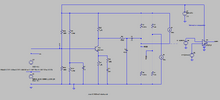Hi,
Do you believe that the attached LTspice simulation is the best way to analyse the effects of the input bias current in one of the comparators inside the STM32L073 (48 pin) microcontroller?
STM32L073 datasheet
https://www.st.com/en/microcontrollers-microprocessors/stm32l073rz.html
I believe the input bias current to the comparator input is +/-50nA (Pg 102 of datasheet)?
Do you believe that the attached LTspice simulation is the best way to analyse the effects of the input bias current in one of the comparators inside the STM32L073 (48 pin) microcontroller?
STM32L073 datasheet
https://www.st.com/en/microcontrollers-microprocessors/stm32l073rz.html
I believe the input bias current to the comparator input is +/-50nA (Pg 102 of datasheet)?


